De Dietrich DRS323JE1 Manual do proprietário
- Tipo
- Manual do proprietário

REFRIGERADOR
FRIGORÍFICO
FRIDGE
DRS323JE
2222 213-82
LES NOUVEAUX OBJECT DE VALEUR
Service Consommateurs De Dietrich
BP 9526 - 95069 Cergy Pontoise Cedex - France
Tel : +33 (0) 825 06 16 04
0,15Eur TTC/MN
Service Après vente De Dietrich
Tel : +33 (0) 801 63 25 25
Prix appel local
Brandt Appliances - 7 rue Henri Becquerel
92854 Rueil-Malmaison cedex - France
S.A.S. au capital de 10 000 000 Euros - RCS Nanterre B 440 302 347

14
ÍNSTALAÇÃO
Instalação
• Durante o normal funcionamento o condensador
e o compressor, colocados na parte de trás do
aparelho, aquecem sensivelmente. Por razões de
segurança a ventilação deve ser como indicado
na respectiva Figura.
Atenção: mantenha as aberturas para a
ventilação livres de qualquer obstrução.
• O aparelho aquece, sensivelmente, ao nível do
con-densador e do compressor. Certifique-se
que o ar circula, livremente, à volta do aparelho.
Uma ventila-ção insuficiente ocasionaria um mau
funcionamen-to, danos para o aparelho e perda
dos alimentos no seu interior. Siga as instruções
para a correcta instalação do aparelho.
• Assegure-se, quando instalar o aparelho, que este
não repousa sobre o cabo de alimentação eléctrica.
Importante: se o cabo de alimentação se danificar,
deverá ser substituído por um cabo especial ou por
um conjunto, disponíveis junto do construtor ou do
serviço de assistência técnica.
• Os componentes do aparelho que aquecem devido
ao seu funcionamento não devem estar expostos.
Sempre que possível as costas do aparelho devem
ficar encostadas a uma parede
• Desligue sempre a tomada de corrente antes de
proceder à limpeza ou qualquer operação de
manutenção do aparelho.
• Ao transportar o aparelho na horizontal, pode
acontecer que o óleo contido no compressor
escorra para o circuito refrigerante. É portanto
aconselhável esperar pelo menos duas horas antes
de ligar o aparelho à corrente.
Protecão do ambiente
Este aparelho não contem, no seu circuito
refrigerante e nas suas matérias isolantes, gases
nocivos à camada de ozono.Mesmo assim este
aparelho deve, quando for destruido,receber os
cuidados convenientes, de acordo com as
disposições em vigor para a protecção do melo
ambiente. Os materiais utilizados neste
aparelho, marcados com o simbolo são
reciclàveis.
Advertencias e conselhos importantes . . . . . . . . . . . . . . . . . . . . . . . . . . . . . . . . . . . . . . . . . . . . . . . . . . .13
Uso / Limpieza las partes internas - Arranque - Régulação da températura - Refrigeração dos alimentos . . .15
Uso / Proteção alimentar - Prateleiras amovíveis - Colocação das prateleiras da porta . . . . . . . . . . . . . . . .16
Uso / Frasqueira - Conselhos / Conselhos para a refrigeração . . . . . . . . . . . . . . . . . . . . . . . . . . . . . . . . . .17
Manutenção / Limpeza periódica - Paragem prolongada - Lâmpara de iluminação - Descongelação . . . .18
Assistência técnica e peças de substituição - Dados técnicos - Instalação / Colocação - . . . . . . . .
Ligação eléctrica - Porta reversível . . . . . . . . . . . . . . . . . . . . . . . . . . . . . . . . . . . . . . . . . . . . . . . . . . . . . . . .19
Instalação / Instruções para encastrar . . . . . . . . . . . . . . . . . . . . . . . . . . . . . . . . . . . . . . . . . . . . . . . . . . . . .20
WARNINGS
It is most important that this instruction book should be retained with the appliance for future
reference. Should the appliance be sold or transferred to another owner, or should you move house
and leave the appliance, always ensure that the book is supplied with the appliance in order that the
new owner can be acquainted with the functioning of the appliance and the relevant warnings.
If this appliance featuring magnetic door seals is to replace an older appliance having a spring lock
(latch) on the door or lid, be sure to make that spring lock unusable before you discard the old
appliance. This will prevent it from becoming a death-trap for a child.
These warnings are provided in the interest of safety.You must read them carefully before installing or
using the appliance.
General Safety
• This appliance is designed to be operated by
adults. Children should not be allowed to tamper
with the controls or play with the product.
• It is dangerous to alter the specifications or
modify this product in any way.
• Before any cleaning or maintenance work is carried
out, be sure to switch off and unplug the appliance.
• This appliance is heavy. Care should be taken
when moving it
• Ice lollies can cause frost burns if consumed
straight from the appliance.
• Take utmost care when handling your
appliance so as not to cause any damages to
the cooling unit with consequent possible
fluid leakages.
• The appliance must not be located close to
radiators or gas cookers.
• Avoid prolonged exposure of the appliance to
direct sunlight.
• There must be adequate ventilation round the
back of the appliance and any damage to the
refrigerant circuit must be avoided.
• For freezers only (except built-in models): an
ideal location is the cellar or basement.
• Do not use other electrical appliances (such
as ice cream makers) inside of refrigerating
appliances.
Service/Repair
• Any electrical work required to install this
appliance should be carried out by a qualified
electrician or competent person
• This product should be serviced by an authorized
Service Centre, and only genuine spare parts
should be used.
• Under no circumstances should you attempt to
repair the appliance yourself. Repairs carried out
by inexperienced persons may cause injury or
more serious malfunctioning. Refer to your local
Service Centre, and always insist on genuine
spare parts.
• This appliance contains hydrocarbons in its
cooling unit; maintenance and recharging must
therefore only be carried out by authorized
technicians.
Use
• The domestic refrigerators and freezers are
designed to be used specifically for the storage
of edible foodstuffs only.
• Best performance is obtained with ambient
temperature between +18°C and +43°C (class T);
+18°C and +38°C (class ST); +16°C and +32°C
(class N); +10°C and +32°C (class SN). The
class of your appliance is shown on its rating
plate.
Warning: when the ambient temperature is not
included within the range indicated for the class
of this appliance, the following instructions must
be observed: when the ambient temperature
drops below the minimum level, the storage
temperature in the freezer compartment cannot
be guaranteed; therefore it is advisable to use the
food stored as soon as possible.
• Frozen food must not be re-frozen once it has
been thawed out.
• Manufacturers’ storage recommendations should
be strictly adhered to. Refer to relevant
instructions.
• The inner lining of the appliance consists of
channels through which the refrigerant passes. If
these should be punctured this would damage the
appliance beyond repair and cause food loss. DO
NOT USE SHARP INSTRUMENTS to scrape off
frost or ice. Frost may be removed by using a
plastic scraper. Under no circumstances should
solid ice be forced off the liner. Solid ice should be
allowed to thaw when defrosting the appliance.
23

13
ADVERTÊNCIAS E CONSELHOS IMPORTANTES
É muito importante que este manual de utilização acompanhe o aparelho para garantir uma futura utilização
correcta. Se o aparelho for vendido ou emprestado a uma outra pessoa, o manual de utilização deve, como
acima se faz notar, acompanhá-lo, de maneira que o utilizador possa ser informado do seu funcionamento,
das advertências e conselhos. Se este aparelho, munido de fecho magnético, veio substituir um outro que
tinha portas com fecho de mola, aconselhamos a inutilizar este fecho, antes do aparelho ser posto
definitivamente de lado. Esta precaução procura evitar que crianças, brincando, se possam fechar no
aparelho o que seria altamente perigoso.
Essas advertências têm por fim garantir a segurança dos utilizadores. Agradecemos, portanto, que leia o
manual atentamente, antes de instalar e utilizar o aparelho.
Segurança
• Este aparelho foi concebido para ser utilizado por
adultos. Deve, por isso, pô-lo ao abrigo das crianças
não consentindo que dele se sirvam como brinquedo.
• É perigoso modificar ou tentar modificar as
características deste aparelho.
• Este aparelho é pesado. Tenha o maior cuidado
quando o deslocar
• Não consuma certos produtos, tais como gelados,
imediatamente após terem saído do aparelho; a
temperatura muito baixa a que se encontram pode
provocar queimaduras.
• Este aparelho contém hidrocarbonetos no
circuito refrigerante; portanto, a manutenção e
a recarga devem ser efectuadas
exclusivamente por pessoal autorizado pelo
produtor.
• Preste a máxima atenção ao deslocar o
aparelho, para não danificar as partes do
circuito refrigerante, evitando assim possíveis
saídas de fluido.
• O aparelho não deve ser instalado perto de
elementos de aquecimento ou fogões de gás.
• Evite a exposição prolongada do aparelho aos
raios do sol.
• A parte de trás do aparelho deve receber uma
suficiente ventilação e deve ser evitado
qualquer dano ao circuito refrigerante.
• Somente para os congeladores (excepto os de
encaixe): a melhor colocação é na cave.
Assistência
• Se uma eventual modificação da instalação eléctrica,
na casa do utilizador, tiver de ser feita para tornar
possível a instalação do aparelho, deve, esta, ser
efectuada por pessoal qualificado.
• Este aparelho deve ser assistido por um Centro de
Assistência autorizado, sendo apenas aplicadas
peças de origem.
• Em caso de avaria, não tente você mesmo, reparar o
aparelho. As reparações executadas por pessoas
inexperientes, podem causar danos físicos e mate-
riais (aumentando as avarias a serem reparadas).
Faça apelo ao seu Centro de Assistência mais
próximo e insista em peças genuínas.
Utilização
• Os frigoríficos e/ou congeladores domésticos
destinam-se, unicamente, à conservação e/ou
congelação de alimentos.
• Os melhores rendimentos são conseguidos com
temperaturas ambiente incluídas entre +18°C e
+43°C (Classe T); +18°C e +38°C (Classe ST);
+16°C e +32°C (Classe N); +10°C e +32°C
(Classe SN); a classe a que pertence o aparelho
é indicada na placa de matrícula (posta na cela
ao lado do compartimento dos legumes).
Atenção: com temperaturas ambiente não
incluídas nas indicadas para a classe climática a
que pertence o produto, é preciso cumprir as
indicações seguintes: quando a temperatura
ambiente descer abaixo do valor mínimo, pode
não ser garantida a temperatura de conservação
no compartimento congelador; portanto,
aconselha-se a consumar rapidamente os
alimentos nele contidos.
• Um produto descongelado não deve, em
nenhum caso, voltar a ser congelado.
• Siga as indicações do fabricante para a
conservação e/ou congelação dos alimentos.
• O revestimento interior do aparelho em composto
de pequenos tubos por onde passa o refrigerante.
Se estes tubos forem danificados o aparelho ficará
irremediavelmente avariado, provocando a perda
dos alimentos no seu interior. NÃO UTILIZE
OBJECTOS PONTEAGUDOS para raspar o gelo
acumulado. Esse gelo pode ser raspado utilizando a
espátula. Para eliminar grandes quantidades de
gelo acumulado, é aconselhável deixá-lo derreter.
Veja as instruções para a descongelação.
• Não coloque no compartimento/congelador a baixa
temperatura, garrafas ou latas com bebidas
gaseificadas dado que se cria uma pressão elevada
no interior da garrafa e/ou lata havendo o perigo de
este explodir. Desta explosão resultariam danos
graves para o aparelho.
24
CONTENTS
Warnings . . . . . . . . . . . . . . . . . . . . . . . . . . . . . . . . . . . . . . . . . . . . . . . . . . . . . . . . . . . . . . . . . . . . . . . . . . .23
Use - Cleaning the interior - Operation - Temperature regulation - Fresh food refrigeration . . . . . . . . . . . . . . . .25
Use - Food protection - Movable shelves - Positioning the door shelves . . . . . . . . . . . . . . . . . . . . . . . . . . . . . . .26
Use - Bottle holder - Hints - Hints for refrigeration . . . . . . . . . . . . . . . . . . . . . . . . . . . . . . . . . . . . . . . . . . . . . . . .27
Maintenance - Periods of no operation - Periodic cleaning - Interior light - Defrosting . . . . . . . . . . . . . . . . .28
Customer service and spare parts - Technical information - Installation - Location - Electrical . . . . . .
connection - Door reversibility . . . . . . . . . . . . . . . . . . . . . . . . . . . . . . . . . . . . . . . . . . . . . . . . . . . . . . . . . . . .29
Installation -Building-in instructions . . . . . . . . . . . . . . . . . . . . . . . . . . . . . . . . . . . . . . . . . . . . . . . . . . . . . . .30
• Do not place carbonated or fizzy drinks in the
freezer as it creates pressure on the container,
which may cause it to explode, resulting in
damage to the appliance. Do not use a
mechanical device or any artificial means to
speed up the thawing process other than those
recommended by the manufacturer. Never use
metal objects for cleaning your appliance as it
may get damaged.
Installation
• During normal operation, the condenser and
compressor at the back of the appliance heat up
considerably. For safety reasons, minimum
ventilation must be as shown in the instructions.
Attention: keep ventilation openings clear of
obstruction.
• Care must be taken to ensure that the appliance
does not stand on the electrical supply cable.
Important: if the supply cord is damaged, it must
be replaced by a special cord or assembly availa-
ble from the manufacturer or its service agent.
• If the appliance is transported horizontally, it is
possible that the oil contained in the compressor
flows in the refrigerant circuit. It is advisable to
wait at least two hours before connecting the
appliance to allow the oil to flow back in the
compressor.
• There are working parts in this product which
heat up. Always ensure that there is adequate
ventilation as a failure to do this will result in
component failure and possible food loss. See
installation instructions.
• Parts which heat up should not be exposed.
Wherever possible the back of the product should
be against a wall.
Environment Protection
This appliance does not contain gasses which
could damage the ozone layer, in either its
refrigerant circuit or insulation materials.The
appliance shall not be discarded together with
the urban refuse and rubbish. Avoid damaging
the cooling unit, especially at the rear near the
heat exchanger. Information on your local
disposal sites may be obtained from municipal
authorities.The materials used on this appliance
marked by the symbol are recyclable.

12
Abrir la puerta del aparato y la del mueble a 90°
aprox. Introducir la escuadrita (B) en la guía (A).
Mantener unidas la puerta del aparato y la del
mueble y marcar los agujeros según se indica en la
figura.
Quitar las escuadritas y hacer unos agujeros de 2
mm de Ø a 8 mm desde el borde exterior de la
puerta. Colocar otra vez la escuadrita sobre la guía
y fijarla con los tornillos presentes en el equipo
base.
8mm
PR167
A
B
PR33
C
A
Introducir la tapa (C), presionándola hasta oír el
resorte, en la guía (A).
PR167/1
D
B
Introducir la tapa (D), presionándola hasta oír el
resorte, en la guía (B)
PR168
En caso de que sea necesario alinear la puerta del
mueble, utilizar el juego de los agujeros de ojal.
Al término de las operaciones es preciso controlar
que la puerta del aparato esté cerrada
correctamente.
25
Cleaning the interior
Before using the appliance for the first time, wash
the interior and all internal accessories with luke-
warm water and some neutral soap so as to remove
the typical smell of a brand-new product, then dry
thoroughly.
Do not use detergents or abrasive
powders, as these will damage the finish.
USE
Operation
Insert the plug into the wall socket.
Open the refrigerator door and turn the thermostat
knob, clockwise, beyond the «O» (STOP) position.
The appliance will start to operate. To stop
operation, simply turn the thermostat knob to
position «O»
Temperature regulation
The temperature is automatically regulated and can
be increased to achieve a higher temperature
(warmer) by rotating the thermostat knob toward
lower settings or reduced (colder) rotating the knob
towards higher settings.
However, the exact setting should be chosen
keeping in mind that the temperature inside the
refrigerator depends on:
• room temperature;
• how often the door is opened;
• the quantity of food stored;
• location of appliance.
A medium setting is generally the most suitable.
Important
If the ambient temperature is high or the
appliance is fully loaded, and the appliance is
set to the lowest temperatures, it may run
continuously causing frost to form on the rear
wall. In this case the dial must be set to a higher
temperature to allow automatic defrosting and
therefore reduced energy consumption.
Fresh food refrigeration
To obtain the best performance:
• do not store warm food or evaporating liquids in
the refrigerator;
• do cover or wrap the food, particularly if it has a
strong flavour.
• Position food so that air can circulate freely round it.

11
Apoyar la guía (A) sobre la parte interior de la
puerta del mueble arriba y abajo según se indica en
la figura y marcar la posición de los agujeros
exteriores. Una vez que se hayan hecho los
agujeros, fijar la guía con los tornillos presentes en
el equipo base.
20 mm
A
50mm
PR166
PR266
A
B
C
D
Separar las piezas A, B, C, D según se indica en la
figura.
Colocar les tapas (B) sobre los extremos del perfil y
en los agujeros para la bisagra.
D726
B
D724
Colocar a presión el cubrejuntas entre el aparato y
el mueble.
26
Movable shelves
The walls of the refrigerator are equipped with a
series of runners so that the shelves can be
positioned as desired.
For better use of space, the front half-shelves can lie
over the rear ones.
D338
Positioning the door shelves
To permit storage of food packages of various sizes,
the door shelves can be placed at different heights.
To make these adjustments proceed as follows:
Gradually pull the shelf in the direction of the arrows
until it comes free, then reposition as required.
Explanation of the cold zone signs
The symbol shown here on the left indicates the coldest point inside your refrigerator.
Coldest area: below or equal to +4°C
Meat, poultry, fish, cold cuts, ready-to-eat meals, mixed salads, egg or cream based mixes and cakes, fresh
pasta, cake mixes, pizzas/quiches, fresh foods and fresh-milk cheeses, vegetables ready to be used and
packed in plastic bags and all other fresh foods whose expiry date is associated with a preservation
temperature below or equal to +4°C.
Temperatur indicator
Thermostat must be adjusted Right Temperature
With the temperature indicator you can keep a check that your refrigerator is working properly.
The indicator shows the "OK" symbol when the coldest area reaches a temperature that is below or equal to
4°C.
If the temperature is higher than 4°C the indicator is black so you must adjust the thermostat to make the
temperature drop.
ATTENTION: Keeping the refrigerator door open for a long time will cause the internal temperature to rise. To
measure the temperature correctly, it should be read on the indicator within 30 seconds.
FOOD PROTECTION
PRXXX

10
Instrucciones para la instalación
Dimensiones del hueco
Altura (1) 1225 mm
Profundidad (2) 550 mm
Anchura (3) 560 mm
Para una adecuada ventilación seguir les
indicaciones de la Fig.
Atención: mantener las aperuras para la
ventilación libres de cualquier obstáculo.
Es necesario además que el hueco tenga un
conducto de ventilación con estas medidas:
profundidad 50 mm
ancho 540 mm
50 mm
min.
200 cm
2
200 cm
2
min.
D567
PR0
540
50
3
2
1
A
D022
Empujar el aparato en el hueco inasta que el perfil
superior (A) llegue a tope con el mueble.
Abrir la puerta y adosar el aparato contra el lado del
mueble al lado opuesto a la bisagra de la puerta.
Fijar el aparato con los 4 tornillos en dotación. Colo-
car la parrilla de aireación (C) encajándola a presión
y engornar la tapa (D) en posición.
D727
C
D
27
HINTS
Hints for refrigeration
Useful hints:
Meat (all types): wrap in polythene bags and place
on the glass shelf above the vegetable drawer.
For safety, store in this way only one or two days
at the most.
Cooked foods, cold dishes, etc..: these should be
covered and may be placed on any shelf.
Fruit and vegetables: these should be thoroughly
cleaned and placed in the special drawer(s)
provided.
Butter and cheese: these should be placed in
special airtight containers or wrapped in aluminium
foil or polythene bags to exclude as much air as
possible.
Milk bottles: these should have a cap and should
be stored in the bottle rack on the door.
Bananas, potatoes, onions and garlic, if not
packed, must not be kept in the refrigerator.
Bottle holder
Place the bottles (with the opening facing front) in
the pre-positioned shelf.
If the shelf is positioned horizontally, place only
closed bottles.
This bottle holder shelf can be tilted in order to store
previously opened bottles.
To obtain this result, pull the shelf up so it can rotate
upwards and be placed on the next higher level.

9
Conexión eléctrica
Antes de enchufar el aparato, asegurarse de que la
tensión y la frecuencia indicadas en la tarjeta
matrícula, correspondan a las de la instalación
doméstica. Se admite una oscilación de 6% sobre la
tensión nominal.
Para el funcionamiento a tensiones distintas, habrá
que utilizar un autotransformador de potencia
adecuada. Asegurarse de que la toma de corriente y
el enchufe sean compatibles entre sí sin tener que
interponer reducciones ladrones o adaptadores
varios. Si fuera necesario, cambiar la toma de la
instalación de la casa con una adapta.
Es indispensable conectar el aparato a una toma
de tierra eficaz.
Para ello el enchufe del cable de alimentación está
dotado de un adecuado contacto. Si la toma de
corriente de la instalación doméstica no estuviera
conectada a tierra, conectar el aparato a una
instalación de tierra, conforme a las leyes en vigor,
consultando para ello con un técnico especializado.
El fabricante declina toda responsabilidad en el
caso que esta norma no sea respetada.
INSTALACIÓN
Colocación
Situar el aparato lejos de fuentes de calor, como:
radiadores, estufas, exposición directa a los rayos
del sol, etc.
Se debe
poder desenchufar el aparato; por lo tanto
una vez efectuada la instalación es necesario que el
enchufe no quede escondido
Este aparato es conforme a las siguientes
Directivas Comunitarias:
- 87/308 CEE del 2/6/87 relativa a la supresión de
interferencias radio.
- 73/23 CEE 19/02/73 (Baja tensión) y
modificaciones sucesivas;
- 89/336 CEE 03/05/89 (Compatibilidad
electromagnética) y modificaciones sucesivas.
Reversibilidad de las puertas
Durante el transporte la puerta del aparato està
fijada con pernos. Quitar el perno superior e inferior,
segùn el sentido de apertura de la puerta.
COMO ACTUAR SI EL APARATO NO FUNCIONA
Si el aparato presentase anomalías será oportuno
controlar:
• Que esté bien enchufado y que el interruptor de
la instalación eléctrica esté conectado.
• Que no haya un corte de energía eléctrica.
• Que el mando del termostato se encuentre en su
posición correcta.
• Si el compresor funciona sin interrupción,
verificar que el termostato no se encuentre en
una posición
• Además si el aparato hace demasiado ruido
verificar que los costados no estén en contacto
con muebles que pueden causar ruidos o
vibraciones y que la unidad refrigerante no vibre.
• Si se ven restos de agua en el fondo del
refrigerador comprobar que el orificio de
desagüe de la escarcha derretida no esté
obturado (ver cápitulo Desescarche).
Después de hacer las verificaciones anteriores, si la
anomalía persiste, llame al Centro de Asistencia
Técnica más cercano.
Es importante en el momento de llamar
proporcionar la referencia del modelo y el
número de matrícula del aparato indicados en el
certificado de garantía o en la tarjeta matrícula.
DATOS TÉCNICOS
Los datos técnicos se indican en la placa-matrícula situada sobre el lado izquierdo interno del aparato.
28
Defrosting
Frost is automatically eliminated from the evaporator
of the refrigerator compartment every time the motor
compressor stops, during normal use. The defrost
water drains out through a trough into a special
container at the back of the appliance, over the
motor compressor, where it evaporates.
It is important to periodically clean the defrost
water drain hole in the middle of the refrigerator
compartment channel to prevent the water
overflowing and dripping onto the food inside.
Use the special cleaner provided, which you will
find already inserted into the drain hole.
D037
Interior light
The light bulb inside the refrigerator compartment
can be reached as follows:
- unscrew the light cover securing screw.
- unhook the moving part as shown in the figure.
If the light does not come on when the
door is open, check that it is screwed into place
properly. If it still does not light up, change the
bulb.The rating is shown on the light bulb cover.
D411
MAINTENANCE
Unplug the appliance before carrying out
any maintenance operation.
Warning
This appliance contains hydrocarbons in its cooling
unit; maintenance and recharging must therefore
only be carried out by authorized technicians.
Periodic cleaning
Clean the inside with warm water and bicarbonate of
soda. Rinse and dry thoroughly.
Clean the condenser (black grill) and the
compressor at the back of the appliance with a
brush or a vacuum cleaner. This operstion will
improve the performance of the appliance and save
electricity consumption.
Periods of non-operation
When the appliance is not in use for long periods,
take the following precautions:
remove the plug from the wall socket;
remove all food;
defrost and clean the interior and all accessories;
leave the door ajar to allow air to circulate to prevent
unpleasant smells.

8
MANUTENCIÓN
Desenchufar siempre el aparato antes de
proceder a cualquier operación de limpieza.
Atención
Este aparato contiene hidrocarburos en el circuito
refrigerante; por lo tanto el mantenimiento y la
recarga deben ser efectuados exclusivamente por
personal autorizado por la empresa.
Temporadas largas de inactividad
Durante los períodos en los cuales el aparato no
esté funcionando observar las siguientes
precauciones:
• desenchufarlo;
• sacar todos los alimentos;
• limpiar cuidadosamente el interior y todos los
accesorios.
• Dejar las puertas entornadas para facilitar la
circulación del aire, a fin de evitar la formación de
olores desagradables.
Limpieza periódica
Lavar el interior con agua tibia y bicarbonato sódico.
Enjuagar y secar cuidadosamente.
Limpiar el condensador y el motocompresor con un
cepillo o un aspirador. Esta operación mejorará el
funcionamiento con el consiguiente ahorro de
energia.
Lámpara de iluminación
Se puede acceder a la lámpara de iluminación del
compartimento refrigerante efectuando las
siguientes operaciones:
• desatornillar el tornillo de fijación del
cubrelámpara,
• desenganchar la parte móvil como se indica en la
Si con la puerta abierta la luz no se enciende,
controlar que esté bien enroscada; si el defecto no
se corrige, cambiar la bombilla con otra de igual
potencia.
La potencia máxima se indica en el difusor
D411
Desecarche
La escarcha del evaporador del compartimento
refrigerante se elimina automáticamente a cada
interrupcion del motocompresor. El agua de la
escarcha derretida, mediante un canal adecuado, se
recoge en un pequeño depósito colocado en la
parte posterior sobre el motocompresor del aparato,
de donde evapora.
Se recomienda limpiar periódicamente el agujero
de desagüe del agua de desescarche, situado en
la parte central del canal en el compartimiento
refrigerante, utilizando el «limpiador» adecuado
que se encuentra en el agujero, para evitar que
el agua de desescarche caiga sobre los
alimentos.
D037
29
CUSTOMER SERVICE AND SPARE PARTS
If the appliance is not functioning properly, check
that:
• the plug is firmly in the wall socket and the mains
power switch is on;
• there is an electricity supply (find out by plugging
in another appliance);
• the thermostat knob is in the correct position.
• If there are water drops on the bottom of the
cabinet, check that the defrost water drain
opening is not obstructed (see “Defrosting”
section).
• If your appliance is still not working properly after
making the above checks, contact the nearest
service centre.
To obtain fast service, it is essential that when you
apply for it you specify the model and serial number
of your appliance which can be found on the
guarantee certificate or on the rating plate located
inside the appliance, on the bottom left-hand side.
INSTALLATION
Location
The appliance should be installed well away from
sources of heat such as radiators, boilers, direct
sunlight etc.
Electrical connection
Before plugging in, ensure that the voltage and
frequency shown on the serial number plate
correspond to your domestic power supply. Voltage
can vary by ±6% of the rated voltage.
For operation with different voltages, a suitably sized
auto-transformer must be used.
The appliance must be earthed.
The power supply cable plug is provided with a
contact for this purpose.
If the domestic power supply socket is not earthed,
connect the appliance to a separate earth in
compliance with current regulations, consulting a
specialist technician.
The Manufacturer declines all responsibility if
the above safety precautions are not observed.
This appliance complies with the following
E.E.C. Directives:
- 87/308 EEC of 2/6/87 relative to radio interference
suppression.
- 73/23 EEC of 19.2.73 (Low Voltage Directive) and
subsequent modifications;
- 89/336 EEC of 3.5.89 (Electromagnetic
Compatibility Directive) and subsequent
modifications.
ATTENTION!
It must be possible to disconnect the appliance from
the mains power supply; the plug must therefore be
easily accessible after installation.
Door reversibility
The appliance’s door has been locked in position for
transport by means of pins on both sides.According
to the door opening direction, remove relevant pins
at the top and at the bottom.
TECHNICAL INFORMATION
The technical infomation are situated in the rating plate on the internal left side of the appliance .

7
CONSEJOS
Consejos para refrigeración
Para un correcto uso aconsejamos:
Carne: debe ser envuelta en saquitos de plástico y
colocada en el espacio situado sobre los cajones
verdura.
En esta posicíon la carne puede ser conservada
al máximo por 1 a 2 dias.
Alimentos cocinados , platos fríos, etc. tienen
que conservarse bien cubiertos y se pueden
colocar en cualquier bandeja del frigorífico.
Fruta y verdura: una vez lavada, ha de colocarse
en el cajón (cajones) inferior.
Mantequilla y queso: deben colocarse en los reci-
pientes adecuados o envueltos en hojas de
aluminio o politileno, a fin de evitar el contacto con
el aire.
Leche embotellada: bien tapada, en la contropuerta.
Bananas, papas, cebollas y ajo, si no están
confeccionados, no se deben colocar en
frigorífico.
Botellero
Poner las botellas (con la boca hacia adelante) en la
repisa prevista.
Si la repisa está puesta horizontal, poner sólo
botellas cerradas.
Esta repisa botellero se puede inclinar para poder
guardar botellas ya abiertas.
Para ello tirar de la repisa hacia arriba de manera
que pueda girarse y engancharse en la ranura
superior.
30
Open the door and push the appliance against the
side of the kitchen unit opposite to that of appliance
hinges.
Fasten the appliance with 4 screws provided in the
kit included with the appliance. Snap vent grille (C)
and hinge cover (D) into position.
D724
Apply the sealing strip pushing it between the
refrigerator and the adjacent cabinet.
Slide the appliance into the recess, pushing it
against the wall on the handle side.
A
D022
PR0
540
50
3
2
1
D727
C
D
50 mm
min.
200 cm
2
200 cm
2
min.
D567
Building-in instructions
Dimensions of housing
Height (1) 1225 mm
Depth (2) 550 mm
Width (3) 560 mm
For safety reasons, minimum ventilation must be as
shown in Fig.
Attention: keep ventilation openings clear of
obstruction.
It is necessary that the niche is provided with a
conduct of ventilation having the following
dimensions:
Depth 50 mm
Width 540 mm

6
D338
Rejillas movibles
En las paredes del compartimento existen unas
guías que consienten poner las rejillas a distintas
alturas.
Para usar mejor el espacio, los semi-estantes
anteriores se puede sobreponer a los posteriores.
Ubicación estantes de la
contrapuerta
Para permitir el almacenamiento de alimentos de
varias dimensiones, se pueden colocar les repisas a
diferentes alturas. Procedan de esta manera:
Empujen la repisa en el sentido de la flecha inasta
cuando no esté libre y volverla a colocar a la altura
deseada.
Explicación de las señales de la zona fría
El símbolo de al lado indica la ubicación de la zona más fría en su frigorífico.
Zona más fría: inferior o igual a +4°C
Carnes, aves, pescado, embutidos, platos preparados, ensaladas mixtas, preparados y dulces a base de
huevos o nata, pasta fresca, masa para tartas, pizzas/empanadas, productos frescos y quesos a base de leche
fresca, verduras preparadas para el uso envasadas en bolsas de plástico y más en general todos los productos
frescos cuya fecha de caducación está acoplada con una temperatura de conservación inferior o igual a +4° C.
Indicador de temperatura
Termostato a regular Temperatura correcta
El indicador de temperatura consiente controlar el funcionamiento correcto de su frigorífico.
El indicador muestra el símbolo "OK" cuando la zona más fría alcanza una temperatura inferior o igual a 4°C.
Si la temperatura es superior a 4°C, el indicador es negro. Por tanto el usuario debe bajar la temperatura de su
frigorífico regulando el termostato.
ATENCIÓN: La apertura protraída de la puerta del frigorífico implica el aumento de la temperatura interior. Para
la medición correcta de la temperatura, la lectura del indicador se debe hacer en el plazo de 30 segundos.
PROTECCIÓN DE LOS ALIMENTOS
PRXXX
31
D726
B
Apply covers (B) on joint cover lugs and into hinge
holes.
Separate parts A, B, C, D as shown in the figure
PR266
A
B
C
D
Place guide (A) on the inside part of the furniture
door, up and down as shown in the figure and mark
the position of external holes. After having drilled
holes, fix the guide with the screws supplied.
20 mm
A
50mm
PR166
PR33
C
A
Fix cover (C) on guide (A) until it clips into place.

5
Limpieza de las partes internas
Antes del empleo limpiar todas las partes internas
con agua tibia y jabón neutro, a fin de eliminar el
característico olor de nuevo y secarlas luego
cuidadosamente.
No emplear detergentes o polvos
abrasivos que podrían dañar las superficies.
USO
Puesta en marcha
Introducir el enchufe en la toma de corriente. Abrir la
puerta del refrigerador y girar el mando del
termostato, en sentido horario hasta una posición
distinta de la posición «O» (parada). El aparato se
pone en marcha.
El funcionamiento del aparato se interrumpe al girar
el mando en la posicíon «O».
Regulación de la temperatura
La temperatura se regula automaticámente y puede
ser aumentada (menos frío) girando el mando hacia
los números más bajos o bien se puede disminuir
(más frío) girándolo hacia los números más altos.De
todos modos, la colocación del mando se determina
teniendo en cuenta que la temperatura interna
depende:
• de la temperatura ambiente;
• de la frecuencia de aperatura de la puerta;
• de la cantidad de alimentos conservados;
• de la colocación del aparato.
La posición intermedia es generalmente la más
indicada.
Refrigeracíon de alimentos y bebidas
Para utilizar de la mejor manera el compartimiento
refrigerante, es necesario:
• no introducir comidas calientes o líquidos en en
evaporacíon;
• tapar o envolver los alimentos, especialmente si
son aromáticos;
• no colocar sobre las rejillas papeles, cartones o
plásticos que obstaculicen la circulacíon del aire.
Importante:
En las posiciones de máximo frío, con
temperatura ambiente elevada, el
funcionamiento puede ser continuo, con
consiguiente formación de escarcha en la parte
posterior del compartimiento; en tal caso es
necesario girar el mando a una posición de
menor frío, a fin de consentir la eliminacíon
automática de la escarcha y, como
consecuencia, obtener un consumo menor de
energía eléctrica.
32
PR168
PR167/1
D
B
Should the lining up of the furniture door be
necessary, use the clearance of slots.
At the end of operations, it is necessary to check if
the door of the furniture closes properly.
Fix cover (D) on guide (B) until it clips into place.
Open the appliance door and the furniture door at
90°. Insert the small square (B) into guide (A). Put
together the appliance door and the furniture door
and mark the holes as indicated in the figure.
Remove the squares and drill holes with ø 2 mm at 8
mm from the outer edge of the door. Place the small
square on the guide again and fix it with the screws
supplied.
8mm
PR167
A
B

Brandt UK Ltd
Intec Four, Wade Road, Basingstoke, Hampshire RG24 8NE
Brochures and Stockist information : 08707 505 503
All other departments : 01256 308 000
Service fax : 01256 346 877
Sales Order Processing fax : 01256 843 024
Marketing and Home Economist fax : 01256 325 888
Distributor in Ireland :
Quality Electrical Distributors Ltd
143b Slaney Close, Dublin Industrial Estate , Glasnevin, Dublin 11
Sales telephone : 01 878 1996 ; Sales fax : 01 878 1473
Email : [email protected]
ElcoBrandt Suisse SA
Service Après Vente
Route de Soleure 12
2072 St Blaise (NE)
Tél : 032-756-49-89
Fax : 032-756-49-99
Numéro vert : 0800 81 12 34
E-mail : [email protected]

REFRIGERADOR
FRIGORÍFICO
FRIDGE
DRS323JE
2222 213-82
LES NOUVEAUX OBJECT DE VALEUR
Service Consommateurs De Dietrich
BP 9526 - 95069 Cergy Pontoise Cedex - France
Tel : +33 (0) 825 06 16 04
0,15Eur TTC/MN
Service Après vente De Dietrich
Tel : +33 (0) 801 63 25 25
Prix appel local
Brandt Appliances - 7 rue Henri Becquerel
92854 Rueil-Malmaison cedex - France
S.A.S. au capital de 10 000 000 Euros - RCS Nanterre B 440 302 347
-
 1
1
-
 2
2
-
 3
3
-
 4
4
-
 5
5
-
 6
6
-
 7
7
-
 8
8
-
 9
9
-
 10
10
-
 11
11
-
 12
12
-
 13
13
De Dietrich DRS323JE1 Manual do proprietário
- Tipo
- Manual do proprietário
em outras línguas
Artigos relacionados
-
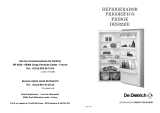 De Dietrich DRS323JE Manual do usuário
De Dietrich DRS323JE Manual do usuário
-
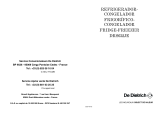 De Dietrich DRS632JE Manual do usuário
De Dietrich DRS632JE Manual do usuário
-
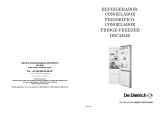 De Dietrich DRC328JE Manual do usuário
De Dietrich DRC328JE Manual do usuário
-
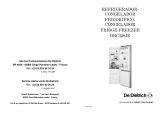 De Dietrich DRC328JE Manual do usuário
De Dietrich DRC328JE Manual do usuário
-
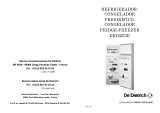 De Dietrich DRD327JE Manual do usuário
De Dietrich DRD327JE Manual do usuário
-
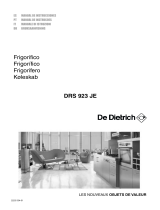 De Dietrich DRS923JE Manual do proprietário
De Dietrich DRS923JE Manual do proprietário
-
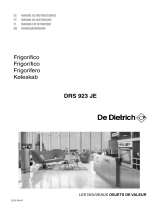 De Dietrich DRS923JE Manual do proprietário
De Dietrich DRS923JE Manual do proprietário
-
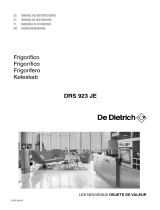 De Dietrich DRS923JE Manual do proprietário
De Dietrich DRS923JE Manual do proprietário
-
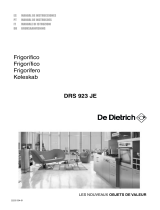 De Dietrich DRS923JE Manual do proprietário
De Dietrich DRS923JE Manual do proprietário





















